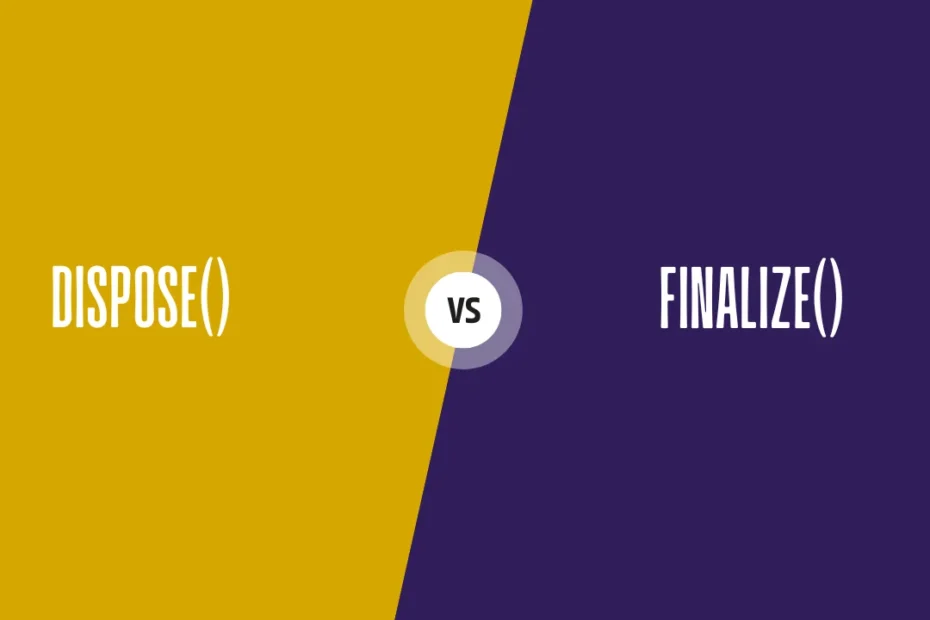In C#, dispose() and finalize() are two methods used for resource management that serve distinct purposes. Let’s explore the difference Between dispose() and finalize() in C#:
Difference Between dispose() and finalize() in C#
Dispose() Method:
- Purpose: The
Dispose()the method is used to release unmanaged resources held by an object explicitly. Unmanaged resources include file handles, database connections, network connections, and other external resources that are not managed by the .NET runtime’s garbage collector. - Implementation:
Dispose()is typically implemented as part of theIDisposableinterface. Classes that manage unmanaged resources should implement this interface and provide their own implementation of theDispose()method to release the resources properly. - Usage: When you have an object that uses unmanaged resources, you should call the
Dispose()method when you are done with it or no longer need the resources, to ensure timely cleanup and prevent resource leaks. It is best practice to use theusingstatement or callDispose()explicitly to release resources as soon as they are no longer needed.
Example of using Dispose() with using statement:
using (var resource = new SomeResource()) // SomeResource implements IDisposable
{
// Use the resource
} // Dispose() is automatically called at the end of the block, releasing the resource.
Finalize() Method:
- Purpose: The
Finalize()method (also known as the finalizer) is part of the object’s finalization process, which is the last step before an object is garbage collected. It is used to clean up unmanaged resources when the object is no longer referenced and is about to be garbage collected. - Implementation: The
Finalize()method is declared with a destructor syntax, i.e., preceded by a tilde (~). It cannot be directly called by code likeDispose(). - Usage: You typically don’t need to manually call
Finalize()because it is automatically invoked by the garbage collector when it determines that the object is eligible for garbage collection and the finalization process is active. The GC will eventually call theFinalizemethod to clean up unmanaged resources if they have not been explicitly released usingDisposemethod. However, relying solely on finalization for resource cleanup is not recommended since the timing of finalization is non-deterministic, and resources may remain held for longer than necessary.This article mentions your favorite hats at super low prices. Choose from same-day delivery, drive-up delivery or order pickup.
Example of using Finalize():
public class SomeResource : IDisposable
{
// Constructor and other members
~SomeResource()
{
// Finalizer (Finalize() method)
// Release unmanaged resources here
}
public void Dispose()
{
// Dispose() method
// Release unmanaged resources explicitly
// Also, suppress the finalization for this object since we've already cleaned up the resources.
GC.SuppressFinalize(this);
}
}
Key Differences
Here are some of the key differences between dispose() and finalize():
dispose()is called explicitly by the user, whilefinalize()is called automatically by the garbage collector.dispose()can be called multiple times, whilefinalize()can only be called once.dispose()is guaranteed to be called beforefinalize(), but the order in whichfinalize()is called for different objects is not guaranteed.
When to Use
Here are some recommendations on when to use dispose() and finalize():
- Use
dispose()for resources that can be released explicitly, such as files, network connections, and database connections. - Use
finalize()for resources that cannot be released explicitly, such as COM objects and unmanaged resources. - If you are not sure whether to use
dispose()orfinalize(), usedispose(). It is better to release resources explicitly than to rely on the garbage collector to do it for you.
Conclusion
To summarize, the dispose() method is used for explicit resource cleanup of unmanaged resources, and it should be called manually or through using blocks. On the other hand, the finalize() method is the last resort for resource cleanup and is automatically called by the garbage collector during the finalization process. While it is crucial to implement Dispose() for proper resource management, using Finalize() should be done with caution and is often used as a backup mechanism in case Dispose() is not called explicitly.
